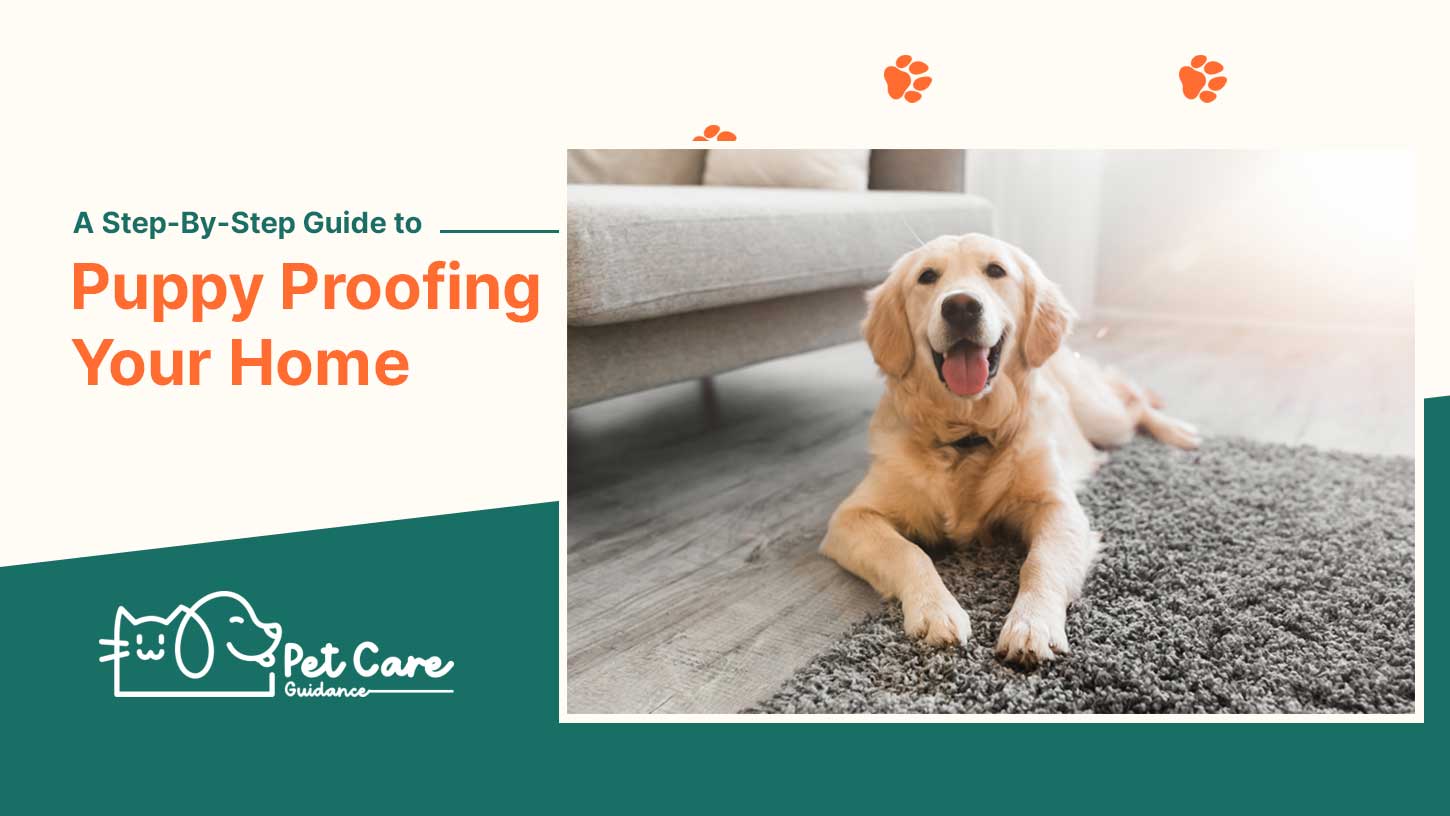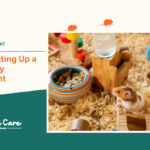Looking to puppy-proof your home? Follow this step-by-step guide to ensure your furry friend stays safe and out of trouble.
Stock up on good pet food, purchase necessary supplies, put prized possessions out of reach, prepare a room just for your puppy, and prepare family members for the new addition. By following these simple steps, you can create a safe and secure environment for your new puppy to thrive in.
Why Puppy Proofing Is Important
Preventing accidents and injuries: It is crucial to puppy proof your home to prevent any accidents or injuries that could harm your furry friend. Puppies are curious and energetic, and they can easily get into dangerous situations. By puppy proofing, you can ensure their safety and well-being.
Protecting your belongings: Puppies love to chew on things, and they can destroy your belongings if they are not properly supervised. Puppy proofing your home will help keep your valuables safe from their playful teeth.
Creating a safe environment for your puppy: Puppy proofing involves removing any potential hazards and creating a safe and secure environment for your puppy to explore. This includes securing electrical cords, locking away toxic substances, and fencing off dangerous areas.
Designating A Puppy-Free Zone
Puppy proofing your home is crucial to ensure your furry friend’s safety. When it comes to designating a puppy-free zone, it is essential to choose a room that will serve as a secure play area. Introduce your puppy to this designated space gradually, allowing them to explore and become familiar with their surroundings. Setting up a secure play area is the first step in creating a safe environment for your puppy.
Clear the room of any potential hazards such as electrical wires, toxic plants, and sharp objects. Consider using baby gates or barriers to restrict access to certain areas of your home. Provide chew toys and interactive toys to keep your puppy entertained and prevent destructive behavior. Remember to supervise your puppy during playtime and gradually increase the freedom they have in the designated space as they grow older and become more responsible. By taking these steps, you can ensure a puppy-friendly home and a happy and healthy companion.
Removing Hazards From Your Home
Puppy proofing your home is essential to ensure your furry friend’s safety as they explore their new surroundings. One important aspect of puppy proofing is securing electrical cords and outlets. Puppies are naturally curious and may chew on cords, which poses a potential electric shock hazard.
To prevent this, you can use cord concealers or move cords out of your puppy’s reach. Additionally, it’s important to store household chemicals and medications in a secure location, such as locked cabinets, to prevent accidental ingestion. Lastly, keep small objects out of reach, as puppies may swallow them and choke. Be mindful of items like buttons, coins, or children’s toys.
By taking these precautions, you can create a safe environment for your new furry friend.
Creating A Safe Outdoor Space
A Step-By-Step Guide to Puppy Proofing Your Home
Fencing off your yard
- Install a secure fence to keep your puppy safely contained within your yard.
- Make sure the fence is high enough to prevent your puppy from jumping over and escaping.
- Regularly check the fence for any gaps or weak spots and repair them promptly.
Removing toxic plants
- Research and identify any toxic plants in your yard.
- Remove these plants or put up barriers to prevent your puppy from accessing them.
- Some common toxic plants include lilies, azaleas, and daffodils.
Removing potential choking hazards
- Scan your yard for any small objects or debris that could pose a choking hazard to your puppy.
- Remove items such as rocks, small toys, or small sticks.
- Keep your yard clean and free of any potential hazards.
Securing Furniture And Belongings
To ensure the safety of your puppy and prevent accidents, it is important to anchor heavy furniture to the wall. Use brackets or straps to secure furniture such as bookshelves, cabinets, and TVs. This will prevent them from toppling over and causing injury to your curious little pup.
Puppies love exploring and chewing on things, so it’s crucial to keep your valuable items and breakables out of their reach. Store fragile items in cabinets, install baby gates to restrict access to certain areas, and consider using decorative mesh or plastic covers to protect delicate items like vases or decorations.
When cleaning your home, it is important to use pet-friendly cleaners. Many household cleaners contain harmful chemicals that can be toxic to puppies. Look for cleaners that are labeled as pet-safe or opt for natural alternatives such as vinegar and baking soda. This will ensure a safe environment for your furry friend.
More Read
Managing Food And Mealtime
When it comes to managing food and mealtime for your puppy, it is essential to take certain steps to ensure their safety and well-being.
- Firstly, **keeping food and garbage secured** is crucial.
Puppies are curious creatures and may try to get into the garbage or steal food from countertops. Make sure to use trash cans with secure lids and place them in an area that is inaccessible to your puppy. Additionally, keep all food items stored in sealed containers and out of reach. - Next, **designating a feeding area**
for your puppy can help establish a routine and create a safe space for them to eat. Choose a quiet area in your home where your puppy can eat without distractions. It can be helpful to use a feeding mat or tray to minimize mess and make cleaning up easier. - Lastly, **establishing routines for mealtime** is essential.
Puppies thrive on consistency, so try to feed them at the same times each day. This will not only help with their digestion but also assist in house training them.
Addressing Potential Health Risks
When it comes to puppy proofing your home, it’s important to address potential health risks. One of the first things you should do is identify and eliminate any poisonous plants that may be in your home or yard. Keep harmful substances, such as cleaning products and medications, out of reach from your puppy.
Regularly check for hazards, such as loose wires or cords, and make necessary changes to ensure your puppy’s safety. Remember to also keep your lawn trimmed and brush under control to prevent your puppy from getting into any dangerous situations outside. By taking these steps, you can create a safe and secure environment for your furry friend.
Supervising And Training
A Step-By-Step Guide to Puppy Proofing Your Home
- Supervise your puppy closely to prevent accidents and destructive behavior.
- Keep your puppy in a designated area or use baby gates to create a safe space.
- Use positive reinforcement techniques, such as rewards and praise, to teach boundaries and encourage good behavior.
- Consistency and patience are key in training your puppy.
- Establish a routine for feeding, potty breaks, and playtime to help your puppy learn what is expected.
- Redirect undesirable behavior by providing appropriate toys and activities.
Seeking Professional Help If Needed
Seeking professional help is an important step in puppy proofing your home. Consulting with a veterinarian or professional trainer can provide valuable guidance and expertise. They can help address specific challenges or behaviors and provide tailored solutions for your puppy’s needs.
Additionally, utilizing resources and support networks can be beneficial. Online forums, training classes, and social media groups can provide a wealth of information and advice from experienced pet owners. These resources can offer practical tips and strategies to help keep your home safe and secure for your furry friend.
Frequently Asked Questions For A Step-By-Step Guide To Puppy Proofing Your Home
How Do I Set Up My House For My Puppy?
- Stock up on healthy pet food and necessary supplies.
- Keep prized possessions out of reach.
- Prepare a designated room for your puppy.
- Prepare your family members for the new addition. Remember to puppy-proof your living room and backyard as well as secure heavy furniture, cover electrical wires and outlets, and store cleaning supplies safely.
How Do I Puppy Proof My Living Room?
To puppy proof your living room, follow these steps:
- Keep wires and cables out of reach.
- Store all food items securely.
- Lock away medicines and cleaning products.
- Remove chairs from surfaces to prevent climbing adventures.
How Do I Make My Backyard Safe For Puppies?
Create a safe backyard for puppies by fencing the yard, removing toxic plants, and putting a fence around pools. Designate a puppy area and keep the lawn trimmed.
How Can I Make My House Dog Proof?
To make your house dog proof, follow these steps:
- Stock up on good pet food and necessary supplies.
- Put prized possessions out of reach.
- Fence the yard and remove toxic plants.
- Add anti-scratch tape, cover electrical cords, and secure HVAC vents.
- Move or block exercise equipment and place remote controls on a high shelf.
- Lock up trash cans, cover electrical wires and outlets, and secure heavy furniture.
- Tie up window treatments and evaluate indoor plants.
- Store medications safely and puppy-proof the bathroom.
- Unplug electrical cords or string them through cord concealers.
- Keep cleaning supplies in cabinets and monitor chewing habits.
- Assess destructive habits and have pet-safe cleaning accidents on hand.
- Keep trash under wraps, cover and contain cords, and properly stow bags.
Conclusion
Puppy proofing your home is an essential step to ensure the safety and well-being of your furry friend. By following this step-by-step guide, you can create a safe environment for your puppy to explore and grow. Start by stocking up on good pet food and necessary supplies.
Put prized possessions out of reach and prepare a designated room just for your puppy. It’s also important to prepare other family members for the new addition. When puppy proofing your living room, be aware of household dangers such as wires and cables, and keep all food out of reach.
Lock away medicines and cleaning products, and ensure that chairs are kept away from other surfaces to prevent climbing adventures. In your backyard, fence the yard if possible and remove toxic plants. Put a fence around in-ground pools and create a designated puppy area.
Keep the lawn trimmed and brush under control. Inside your home, lock up trash cans, cover electrical wires and outlets, and secure heavy furniture. Tie up window treatments and protect indoor plants. Store medications safely and keep cleaning supplies in cabinets.
Remember, puppy proofing is an ongoing process as your pup grows and explores new areas of your home. By following these steps, you can create a safe and happy environment for your furry friend.



